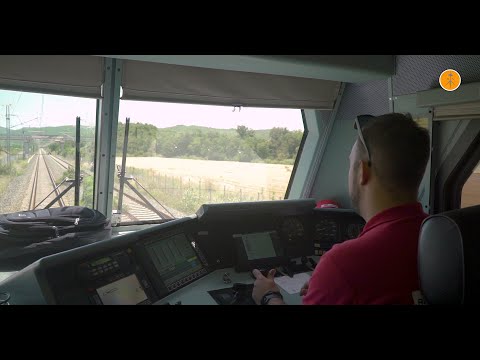Train Driver Job: Description & Salary
Train Driver Job Description
A train driver is responsible for operating locomotives and ensuring the safe and efficient transportation of passengers and freight. Their main job is to adhere to the train schedule, follow all safety procedures, and operate the train in a smooth and controlled manner. Train drivers are also responsible for inspecting the train before and after each journey to ensure that it is in proper working order.
In addition to operating the train, train drivers must also communicate with railway control centers and other train crew members to ensure that there are no issues or delays. They must be able to make quick decisions in emergency situations and handle any unexpected events that may occur during the journey.
Train Driver Salary
The salary of a train driver can vary depending on several factors such as experience, location, and the type of train they are operating. On average, train drivers can expect to earn a competitive salary. In the United States, the average annual salary for a train driver is around $60,000 to $70,000. However, experienced train drivers with many years of service can earn upwards of $100,000 per year.
In addition to a competitive salary, train drivers often receive benefits such as health insurance, retirement plans, and paid time off. Some companies may also offer bonuses or incentives based on performance and years of service.
Overall, working as a train driver can be a rewarding and well-paying career choice for individuals who have a passion for trains and enjoy working in a fast-paced and responsible role.

Train Driver Job Description Template
Train Driver Job Description
Train drivers are responsible for operating locomotives and ensuring the safe and efficient transportation of passengers or goods. They play a crucial role in the transportation industry, as they ensure that trains run on schedule and reach their destinations in a timely manner.
The primary duty of a train driver is to operate trains according to a set schedule. They have to follow specific routes, maintain appropriate speeds, and adhere to all safety regulations. They are also responsible for communicating with control centers and other train crew members to ensure a smooth and coordinated operation.
Safety is of utmost importance in this role. Train drivers must constantly monitor the train’s performance, including its brakes, signals, and other equipment. They must be alert and prepared to respond to any emergencies, such as signal malfunctions or obstacles on the tracks. They must also be familiar with emergency protocols and procedures to handle any unforeseen situations.
Another crucial aspect of being a train driver is customer service. Train drivers interact with passengers on a daily basis, providing them with information, assisting with boarding and disembarking, and ensuring their comfort and safety throughout the journey.
Attention to detail, good communication skills, and the ability to stay calm under pressure are essential qualities for a train driver. They must be able to make quick decisions and react swiftly to ensure the safety of passengers and cargo.
In summary, train drivers are responsible for operating trains, ensuring safety, adhering to schedules, and providing excellent customer service. Their role is vital in keeping the transportation industry running smoothly and efficiently.
Train Driver Responsibilities
Train Driver Requirements
How Much Does A Train Driver Make?
Train Driver Salary
| Country | Average Annual Salary |
|---|---|
| United States | $70,930 |
| United Kingdom | £50,000 |
| Australia | AU$90,000 |
| Germany | €40,000 |
Train drivers play a crucial role in the transportation industry, ensuring the safe and efficient movement of passengers and freight. The salary of train drivers varies depending on the country they work in.
In the United States, train drivers earn an average annual salary of $70,930. In the United Kingdom, the average annual salary is £50,000. In Australia, train drivers can expect to earn around AU$90,000 per year. In Germany, the average annual salary for train drivers is €40,000.
These figures are just averages and can vary depending on factors such as experience, qualifications, and the specific railway company. Additionally, train drivers may also receive benefits such as healthcare and retirement plans.
Becoming a train driver requires specialized training and certifications. It is a challenging yet rewarding career choice for those interested in the transportation industry and enjoy working in a fast-paced and responsible role.
Train Driver Salaries by Country
Top Paying Countries for Train Driver
| Country | Average Annual Salary (USD) |
|---|---|
| Switzerland | $110,000 |
| Norway | $80,000 |
| United States | $70,000 |
| Australia | $65,000 |
| Germany | $60,000 |
Train drivers in Switzerland earn the highest average annual salary of $110,000, making it the top paying country for this profession. Norway follows closely with an average salary of $80,000, while the United States offers an average salary of $70,000. Australia and Germany round up the list with average salaries of $65,000 and $60,000 respectively. These countries prioritize the safety and efficient operation of their rail systems, resulting in higher wages for train drivers compared to other nations.
A video on the topic Train Driver
Video Source : The Hellenic Trainspotters
Interview Questions for Train Driver
1. Can you tell us about your experience as a train driver?
Sure, I have been working as a train driver for the past 10 years. During this time, I have operated various types of trains, including passenger trains and freight trains. I am well-versed in the safety protocols and procedures involved in train operations.
2. What qualifications and certifications do you possess as a train driver?
I have obtained a valid train driver’s license after completing the required training and passing the necessary examinations. I also hold certifications in first aid and emergency response, which are crucial in ensuring passenger safety.
3. How do you handle stressful situations while operating a train?
When faced with stressful situations, I remain calm and focused. I rely on my training and experience to make quick and informed decisions. Effective communication with the control center and other crew members also helps in managing stressful situations efficiently.
4. How do you ensure the safety of passengers and crew members during train operations?
Ensuring the safety of passengers and crew members is my top priority. I strictly adhere to all safety regulations and protocols, including speed limits, signaling systems, and track conditions. Regular equipment checks and maintenance are also essential to prevent any safety issues.
5. How do you handle unexpected disruptions, such as track blockages or mechanical failures?
In the event of unexpected disruptions, I immediately inform the control center and follow their instructions. I work closely with the maintenance team to resolve any mechanical failures as quickly as possible. If necessary, I communicate with passengers to keep them informed about the situation and provide alternative solutions.
6. How do you ensure punctuality while operating a train?
Punctuality is crucial in train operations, and I take it seriously. I carefully plan my routes, considering factors such as track conditions and potential delays. I maintain regular communication with the control center to receive real-time updates and adjust my speed accordingly to ensure on-time arrivals.
7. How do you handle emergencies, such as accidents or medical incidents onboard?
In case of emergencies, I promptly follow the established emergency protocols. I inform the control center and request immediate assistance. I am trained in providing basic first aid, and I ensure that any medical incidents onboard are addressed with utmost care and urgency.
8. How do you stay updated with the latest industry developments and regulations?
I actively participate in professional development programs and attend relevant trainings and workshops. I also stay updated with industry publications and regularly communicate with fellow train drivers to exchange knowledge and experiences. Additionally, I closely follow any updates or changes in regulations issued by the relevant authorities.
9. How do you handle fatigue during long hours of driving?
Fatigue management is crucial for ensuring the safety of train operations. I strictly adhere to the prescribed rest periods and take regular breaks to prevent fatigue. If I feel excessively tired or unable to maintain focus, I immediately inform the control center and request relief.
10. What do you enjoy most about being a train driver?
One of the things I enjoy most about being a train driver is the sense of responsibility that comes with the job. I take pride in ensuring the safe and efficient transportation of passengers and goods. Additionally, the ever-changing scenery and the opportunity to travel to different places make this profession exciting and fulfilling.






